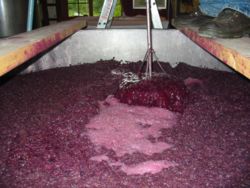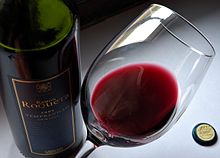Phenolic content in wine

The phenolic content in wine refers to the phenolic compounds—
acids.Origin of the phenolic compounds
The natural phenols are not evenly distributed within the fruit. Phenolic acids are largely present in the pulp,
Wine simple phenols are further transformed during
In
Most wine phenols are classified as
Grape polyphenols
Vitis vinifera produces many phenolic compounds. There is a varietal effect on the relative composition.
Flavonoids

In red wine, up to 90% of the wine's phenolic content falls under the classification of flavonoids. These phenols, mainly derived from the stems, seeds and skins are often leached out of the grape during the maceration period of winemaking. The amount of phenols leached is known as
Flavonols
Within the flavonoid category is a subcategory known as
Anthocyanins
Anthocyanins are phenolic compounds found throughout the
There are several types of anthocyanins (as the
Red-berried

The color variation in the finished red wine is partly derived from the
Tannins
Tannins refer to the diverse group of chemical compounds in wine that can affect the color, aging ability and texture of the wine. While tannins cannot be smelled or tasted, they can be perceived during
Tannins are found in the skin, stems, and seeds of wine grapes but can also be introduced to the wine through the use of oak barrels and chips or with the addition of tannin powder. The natural tannins found in grapes are known as

In the vineyards, there is also a growing distinction being made between "ripe" and "unripe" tannins present in the grape. This "
A study in wine production and consumption has shown that tannins, in the form of proanthocyanidins, have a beneficial effect on vascular health. The study showed that tannins suppressed production of the peptide responsible for hardening arteries. To support their findings, the study also points out that wines from the regions of southwest France and Sardinia are particularly rich in proanthocyanidins, and that these regions also produce populations with longer life spans.[21]
Reactions of tannins with the phenolic compound anthocyanidins creates another class of tannins known as pigmented tannins which influences the color of red wine.[18]
Addition of enological tannins
Commercial preparations of tannins, known as enological tannins, made from
can be added at different stages of the wine production to improve color durability.Effects of tannins on the drinkability and aging potential of wine
Tannins are a natural preservative in wine. Un-aged wines with high tannin content can be less palatable than wines with a lower level of tannins. Tannins can be described as leaving a dry and puckered feeling with a "furriness" in the mouth that can be compared to a stewed tea, which is also very tannic. This effect is particularly profound when drinking tannic wines without the benefit of food.
Many
Other flavonoids
In red grapes, the main flavonol is on average quercetin, followed by myricetin, kaempferol, laricitrin, isorhamnetin, and syringetin.[25] In white grapes, the main flavonol is quercetin, followed by kaempferol and isorhamnetin. The delphinidin-like flavonols myricetin, laricitrin, and syringetin are missing in all white varieties, indicating that the enzyme flavonoid 3',5'-hydroxylase is not expressed in white grape varieties.[25]
Myricetin, laricitrin[26] and syringetin,[27] flavonols which are present in red grape varieties only, can be found in red wine.[28]
Non-flavonoids
Hydroxycinnamic acids
Hydroxycinnamic acids are the most important group of nonflavonoid phenols in wine. The four most abundant ones are the
Stilbenoids
V. vinifera also produces stilbenoids.
Piceatannol is also present in grape [33] from where it can be extracted and found in red wine.[28]
Phenolic acids
Vanillin is a phenolic aldehyde most commonly associated with the vanilla notes in wines that have been aged in oak. Trace amounts of vanillin are found naturally in grapes, but they are most prominent in the lignin structure of oak barrels. Newer barrels will impart more vanillin, with the concentration present decreasing with each subsequent usage.[34]
Phenols from oak ageing

Oak barrel will add compounds such as
Natural phenols and polyphenols from cork stoppers

Low molecular weight polyphenols, as well as ellagitannins, are susceptible to be extracted from
Guaiacol is one of the molecules responsible for the cork taint wine fault.[39]
Phenolic content in relation with wine making techniques
Extraction levels in relation with grape pressing techniques
Microoxygeneation
The exposure of wine to oxygen in limited quantities affects phenolic content.[42]
Phenolic compounds found in wine

Depending on the methods of production, wine type, grape varieties, ageing processes, the following phenolics can be found in wine. The list, sorted in alphabetical order of common names, is not exhaustive.
- Acutissimin A
- aesculetin
- Anthocyanidin-caftaric acid adducts[43][44]
- Astilbin
- Astringin
- B type proanthocyanidin dimers
- B type proanthocyanidin trimers
- Caffeic acid
- Caftaric acid
- Castalagin
- Castavinol C1
- Castavinol C2
- Castavinol C3
- Castavinol C4
- Catechin[45]
- Catechin-(4,8)-malvidin-3-O-glucoside[46]
- Compound NJ2
- Coniferyl aldehyde
- Coumaric acid[45]
- Coutaric acid
- Cyanidin
- Cyanin(Cyanidin-3,5-O-diglucoside)
- Cyanidin 3O-glucoside
- Cyanidin acetyl 3O glucoside
- Cyanidin coumaroyl 3O glucoside
- Cyanidin-3-O-glucoside-pyruvic acid
- Cyanidin-3-O-acetylglucoside-pyruvic acid
- Cyanidin-coumaroylglucoside-pyruvic acid
- Delphinidin
- Delphinidin 3O glucoside
- Delphinidin acetyl-3O glucoside
- Delphinidin coumaroyl 3O glucoside
- Delphinidin-3-O-glucoside-pyruvic acid
- Delphinidin-3-O-acetylglucoside-pyruvic acid
- Delphinidin-3-O-coumaroylglucoside-pyruvic acid
- Delphinidin-3-O-glucoside-4-vinylcatechol
- Delphinidin-3-O-acetylglucoside-4-vinylcatechol
- Delphinidin-3-O-coumaroylglucoside-4-vinylcatechol
- Delphinidin-3-O-glucoside-4-vinylphenol
- Delphinidin-3-O-acetylglucoside-4-vinylphenol
- Delphinidin-3-O-coumaroylglucoside-4-vinylphenol
- Delphinidin-3-O-glucoside-4-vinylguaiacol
- Delphinidin-3-O-glucoside-4-vinyl(epi)catechin
- Delphinidin-3-O-acetylglucoside-4-vinyl(epi)catechin
- Delta-viniferin
- Dihydro-resveratrol[47]
- Ellagic acid
- Engeletin
- Epicatechin gallate
- Epigallocatechin
- Epsilon-viniferin
- Ethyl caffeate
- Ethyl gallate
- Ethyl protocatechuate
- 4-Ethylguaiacol
- 4-Ethylphenol
- Fertaric acid
- Ferulic acid
- Gallic acid[45]
- Gentisic acid
- Grandinin
- Grape reaction product (GRP)
- Guaiacol
- Hopeaphenol
- p-Hydroxybenzoic acid
- Isorhamnetol 3-glucoside
- Kaempferol
- Kaempferol glucoside(astragalin)
- Kaempferol glucuronide
- Malvidin
- Malvidin 3O-glucoside(oenin)
- Malvidin acetyl-3O-glucoside
- Malvidin cafeoyl-3O-glucoside
- Malvidin coumaroyl-3Oglucoside
- Malvidin glucoside-ethyl-catechin
- Malvidin-3-O-glucoside-pyruvic acid
- Malvidin-3-O-acetylglucoside-pyruvic acid
- Malvidin-3-O-coumaroylglucoside-pyruvic acid
- Malvidin-3-O-glucoside-acetaldehyde
- Malvidin-3-O-acetylglucoside-acetaldehyde
- Malvidin-3-O-coumaroylglucoside-acetaldehyde
- Malvidin-3-O-glucoside-4-vinylcatechol
- Malvidin-3-O-acetylglucoside-4-vinylcatechol
- Malvidin-3-O-coumaroylglucoside-4-vinylcatechol
- Malvidin-3-O-glucoside-4-vinylphenol
- Malvidin-3-O-acetylglucoside-4-vinylphenol
- Malvidin-3-O-coumaroylglucoside-4-vinylphenol
- Malvidin-3-O-caffeoylglucoside-4-vinylphenol
- Malvidin-3-O-glucoside-4-vinylguaiacol
- Malvidin-3-O-acetylglucoside-4-vinylguaiacol
- Malvidin-3-O-coumaroylglucoside-vinylguaiacol
- Malvidin-3-O-glucoside-4-vinyl(epi)catechin
- Malvidin-3-O-acetylglucoside-4-vinyl(epi)catechin
- Malvidin-3-O-coumaroylglucoside-4-vinyl(epi)catechin
- Methyl gallate
- Myricetol
- Myricetol 3-glucoside
- Myricetol 3-glucuronide
- Oxovitisin A
- Pallidol
- Pelargonin (Pelargonidin 3,5-O-diglucoside)
- Peonidin 3O-glucoside
- Peonidin acetyl-3O-glucoside
- Peonidin-3-(6-p-caffeoyl)-glucoside
- Peonidin coumaroyl 3O-glucoside
- Peonidin-3-O-glucoside-pyruvic acid
- Peonidin-3-O-acetylglucoside-pyruvic acid
- Peonidin-3-O-coumaroylglucoside-pyruvic acid
- Peonidin-3-O-glucoside-4-vinylcatechol
- Peonidin-3-O-acetylglucoside-4-vinylcatechol
- Peonidin-3-O-coumaroylglucoside-4-vinylcatechol
- Peonidin-3-O-glucoside-4-vinylphenol
- Peonidin-3-O-acetylglucoside-4-vinylphenol
- Peonidin-3-O-coumaroylglucoside-4-vinylphenol
- Peonidin-3-O-glucoside-4-vinylguaiacol
- Peonidin-3-O-glucoside-4-vinyl(epi)catechin
- Peonidin-3-O-acetylglucoside-4-vinyl(epi)catechin
- Petunidin
- Petunidin 3O glucoside
- Petunidin acetyl-3O-glucoside
- Petunidin coumaroyl-3O glucoside
- Petunidin-3-O-glucoside-pyruvic acid
- Petunidin-3-O-acetylglucoside-pyruvic acid
- Petunidin-3-O-coumaroylglucoside-pyruvic acid
- Petunidin-3-O-glucoside-4-vinylcatechol
- Petunidin-3-O-acetylglucoside-4-vinylcatechol
- Petunidin-3-O-coumaroylglucoside-4-vinylcatechol
- Petunidin-3-O-glucoside-4-vinylphenol
- Petunidin-3-O-acetylglucoside-4-vinylphenol
- Petunidin-3-O-coumaroylglucoside-4-vinylphenol
- Petunidin-3-O-glucoside-4-vinylguaiacol
- Petunidin-3-O-glucoside-4-vinyl(epi)catechin
- Petunidin-3-O-acetylglucoside-4-vinyl(epi)catechin
- Phloroglucinol carboxylic acid
- Piceatannol
- Piceids
- Pinotin A
- Oligomeric procyanidins :
- Procyanidin B1
- Procyanidin B2
- Procyanidin B3
- Procyanidin B4
- B1-3-O-gallate
- B2-3-O-gallate
- B2-3'-O-gallate
- procyanidin C1 (epicatechin-(4β→8)-epicatechin-(4β→8)-epicatechin)
- Procyanidin C2 (catechin-(4α→8)-catechin-(4α→8)-catechin)
- procyanidin T2 (trimer)[48]
- Protocatechuic acid
- protocatechuic aldehyde
- Quercetin
- Quercetol glucoside
- Quercetol glucuronide
- Resveratrol
- Roburin A
- Roburin E
- Scopoletin
- Sinapic aldehyde
- Sinapinic acid
- Syringic acid
- Tyrosol
- Vanillic acid
- vanillin
- Vescalagin
- 4-Vinylphenol
- Vitisin A
- Vitisin B
- Vinylpyranomalvidin-3O-glucoside-procyanidin dimer
- VinylpyranoMv-3-coumaroylglucoside-procyanidin dimer
- Vinylpyranomalvidin-3O-glucoside-catechin
- Vinylpyranomalvidin-3O-coumaroylglucoside-catechin
- Vinylpyranomalvidin-3O-phenol
- Vinylpyranopetunidin-3O-glucoside-catechin
- Vinylpyranopeonidin-3O-glucoside-catechin
- Vinylpyranomalvidin-3O-acetylglucoside-catechin
Effects
Polyphenol compounds may interact with
See also
- Aging of wine
- Clarification and stabilization of wine
- Grape seed extract
- Phenolic content in tea
- Wine chemistry
References
- S2CID 10545757.
- PMID 25417599.
- S2CID 84044849.
- S2CID 86822376.
- ISBN 0-19-860990-6.
- PMID 11402184.
- ISBN 0-19-860990-6.
- ^ S2CID 230556619.
- ^ ISBN 0-19-860990-6.
- PMID 19338353.
- PMID 21150825.
- PMID 16997314.
- .
- PMID 14599515.
- PMID 10563846.
- ^ ISBN 0-19-860990-6.
- ^ .
- ^ a b Compositional investigation of pigmented tannin. Kennedy James A. and Hayasaka Yoji, A.C.S. symposium series, 2004, vol. 886, pp. 247-264, INIST 16184447
- ^ a b Identification of the origin of commercial enological tannins by the analysis of monosaccharides and polyalcohols. Luz Sanz M., Martinez-Castro Isabel and Moreno-Arribas M. Victoria, Food chemistry, 2008, vol. 111, no3, pp. 778-783, INIST 20520307
- ^ S2CID 88027174.
- S2CID 4303406.
- ^ "Wine Lovers Page - Wine Lexicon: Tannic, tannis". Archived from the original on July 18, 2011.
- ^ Wallace, Keith S (2005). "What are Tannins in Wine?". Wine School.
- ISBN 0-19-860990-6.
- ^ PMID 17002441.
- ^ Flavonol profiles of Vitis vinifera red grapes and their single-cultivar wines. Castillo-Munoz Noelia, Gomez-Alonso Sergio, Garcia-Romero Esteban and Hermosin-Gutierrez Isidro, Journal of agricultural and food chemistry, 2007, vol. 55, no3, pp. 992-1002? INIST 18502213
- PMID 19784998.
- ^ PMID 16216908. Retrieved 3 March 2015.
- .
- PMID 19032022.
- S2CID 46152576.
- ISBN 0-19-860990-6.
- ^ Bavaresco L.; Fregoni M.; Trevisan M.; Mattivi F.; Vrhovsek U; Falchetti R. (2002). "The occurrence of piceatannol in grape". Vitis. 41 (3): 133–6.
- ISBN 0-19-860990-6.
- ISBN 0-19-860990-6.
- PMID 10768504.
- .
- PMID 12644227.
- ^ Flash release and wine quality. Escudier J.L., Kotseridis Y. and Moutounet M., Progrès Agricole et Viticole, 2002 (French)
- PMID 16756356.
- .
- .
- .
- ^ PMID 25471637.
- PMID 20925351.
- PMID 20813524.
- .
- PMID 10563952.
- ^ S2CID 26520546.
- ^ "Flavonoids". Linus Pauling Institute, Micronutrient Information Center, Oregon State University. 2015. Retrieved 11 June 2017.
- .
- PMID 17141749.
